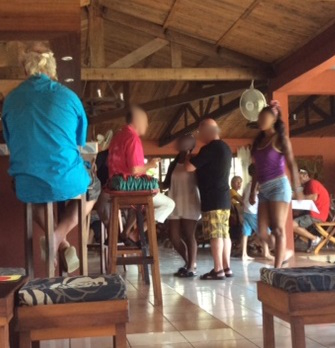Anywhere a French minister goes, other than the toilet perhaps, they can expect hostility. They don’t mind much – it comes with the territory. In this case, the minister is George-Pau Langevin and the territory is Mayotte. No longer a territoire, in fact – since 2011 a département. Mme Langevin, Minister of Overseas, does just that – oversees (sorry…) the DOM-TOM, the départements and territoires d’outre-mer. So obviously, her visit to Mayotte sparked grumbles all round – health, security, education, environment, infrastructure, housing… When it comes to bringing Mayotte up to the standards of the Metropole, it’s difficult to know where to start
This post, though, is not to do with Mayotte, about which I’ve written elsewhere,* but about the Glorioso Islands, or Îles Glorieuses. Because the first grumble around the minister’s visit was her timetable – yesterday morning, rather than discuss the problems of Mayotte, she whizzed off in a military jet to Grande Glorieuse, the largest of the islands that make up the Glorioso Archipelago. ‘Large’ here is relative: there are two actual islands, a few rocks and sandbanks, and the whole lot together cover 7 square kilometres.
So what did she do in the couple of hours she was there? Officially, she observed and encouraged the efforts undertaken by France to protect the biodiversity of the area. The coral reefs are indeed among the earth’s most treasured assets, definitely not to be messed with. She would also have had a little chat and a cup of coffee (no croissants, though) with the islands inhabitants, 14 soldiers and one gendarme, who doubles up as the postman. Nothing too taxing and no great issues to debate. So why did she even go there?
Well, it just so happens that over the past few months, the matter of who the islands really belong to has flared up in Madagascar. Not just the Glorieuses, in fact, but the whole of the Îles Eparses, or Scattered Islands, of which the Glorieuses are a part. A glance at the map shows just how completely Madagascar is surrounded by French territory. Only La Réunion is indisputably French: the five tiny spots of the Îles Eparses are contested by Madagascar, while Mayotte is contested by the Comores.
Now far from me the idea that France is not devoted to the biodiversity around these scattered rocks, but when you bear in mind that the territorial waters are also rich in fossil fuels, you begin to see why such devotion is so convenient. Madame Langevin’s little chat with the soldiers was also saying to Madagascar, ‘C’est à nous!’
The conflict goes back to the 1960s, when Madagascar became independent. In 1979, the UN ‘invited’ France to return the Scattered Islands to Madagascar, but for some reason the invitation was declined. A proposal last year by Madagascar to manage the islands jointly was similarly turned down. France is quite partial, it seems, to uninhabited rocks.
* A brief, tongue-in-cheek history of Mayotte is here, whilst a more general overview, including the immigration issue, is here.
Just in the nick of time, I believe (the minister omitted to consult me regarding dates), this post is part of Phoebe’s All About France link up, not forgetting TJ Paris’s French Friday feature.







































